(UPDATED 2019) “What’s the best beach for you?” I asked an adventurous blogger friend, who was known to just pick a place off the map and go. If he spotted a promising strip of white sand via Google Earth, he would make plans to go there.
A few years have already passed since he gave his answer to my question, but I never forgot it, and I vowed to go to his favorite beach one day. The other weekend, I finally set foot on the island he had so raved about, and it was everything he had told me, and more.

Alibijaban Island’s beauty
Alibijaban is an island located at the southernmost municipality of Quezon, San Andres, and is around 30 kilometers by boat away from Masbate’s Burias Island. At over 400 hectares, Alibijaban is blessed with stretches of pure white sand sand, clear waters, and lush mangroves. Its 140-hectare mangrove forest is a protected wilderness area. The island is fringed by seagrass beds and coral reefs, and neighboring waters are said to be visited by whale sharks and manta rays, which is not surprising, as the island is relatively near Bicol’s Donsol, known for whale sharks, and Ticao Island, known for manta rays.
The island has a slow and laidback atmosphere, the people open and friendly. Locals smiled and greeted us with ease. Given how Alibijaban is relatively near Manila (at least seven hours of travel time) and how it is just 20-30 minutes away from Quezon’s mainland, I was surprised how much it nostalgically felt like the small islands I love in Visayas, like Higatangan. Alibijaban has a small population (1,643 as of 2015), and has two elementary schools, though not a high school. Its waters are drawn from natural wells, and while its electricity is limited and runs only on solar panels and generators, its people’s smiles seem to be in infinite supply. The last one is my favorite in Alibijaban and the other islands that remind me of it. This was also what my adventurous traveler friend who recommended Alibijaban loved about the island.

The moment we docked, we already saw children playing at the shore. Locals here are quite friendly.
Small wonder, though, that Alibijaban reminded me of some of Visayas’ islands, as I found out later that the people here speak a mixture of Bisaya and Tagalog. The origin of the name of the island has little to do with either language, though, as our host shared me a story from the island’s elders – that the name came from the combination of a couple’s names who visited the island – “Alibi” and “Jaban.”
Getting to the island is a manageable overnight trip. In our group’s case, our rented van left Quezon City around 1 am on Saturday, stopped for our breakfast at Lucena before 5 am, and arrived at San Andres around 10:30 am. Here, we were welcomed by our local guide and host Ronnel Lirasan, and we went shopping together at the public market for ingredients for our meals on the island.

Shopping at San Andres’ public market

From the market, our shopping group rode side cars to the port, where the van and the rest of our friends were waiting.

At the port area

Our host and guide Ronnel (the guy in yellow) loading the boat with our meal ingredients, with the help of another local.
While the skies were gray, the sea was calm, and our boat ride took less than 30 minutes. Even from afar, the stretch of white sand visibly stood out like a promise, and we were more than happy to set foot on the island, where we immediately saw children walking or playing by the shore.

The sight that greeted us once our boat docked
I planted my feet on the sand, and I was surprised how the latter easily molded itself to my sandals. I took off my sandals and realized that the sand was powdery fine there. Other parts had crushed coral, but were still easy to walk on barefoot.

Powdery white sand welcomed my already tanned feet.
I noticed some, but not overwhelmingly many, tents pitched by the shore. There were also hammocks tied to some trees.

Some campers by the shore
Passing by the activities at the shore, we then made our way to our host and guide Ronnel’s family home, also our home during our overnight stay on the island. We dropped our bags inside their humble hut accommodations and had lunch.

The grounds of our host and guide Ronnel’s family home. This was also where we had our meals.

One of the two simple rooms Ronnel’s family has reserved for guests. Each fits around 4-5 people, if the woven mat is also laid out on the floor.

(APRIL 2019) The accommodation by Ronnel and his family is now these beautiful huts fitting 4-5 people at P1000 each. The bigger hut in the distance fits at least 10 (P2000).
Our meals were usually a generous spread of fruits, rice, fish, seafood, and meat, with some of the fish and seafood fresh from the island’s waters, in addition to what we bought at the mainland’s public market. Ronnel’s mom Nanay Genine prepared all our meals, sometimes with the help of her husband, also a kagawad (a local government official) of Alibijaban, and other sons.

Our meals are usually a generous spread of fruits, rice, fish, seafood, and meat. Rice and fried fish not shown on photo.
After our first meal on the island, we were ready to explore.

But first, I relaxed on one of the island’s hammocks as some of them started taking a dip.
We walked along the shore line generously shaded by trees with leaves that looked like tamarind leaves and came to a spot where the white sand curved into the waters, forming what looked like a sand bar. It was at this point that I noticed the sun coming out and the gray sky brightening into blue, making the scene paradisical.

The sand curved into what reminded me of a sand bar before it receded back to the shore.
Some of us walked farther along the shore, while others were contented with swimming and taking photos.

(APRIL 2019) Alibijaban’s shores are still beautiful.
The noonday heat and the feeling of fullness after our lunch, though, prompted some of us to spread out and lie on mats, and others to rest on benches under the trees. I easily fell asleep under one of the tamarind-like trees, which I recently found out were locally called aroma.
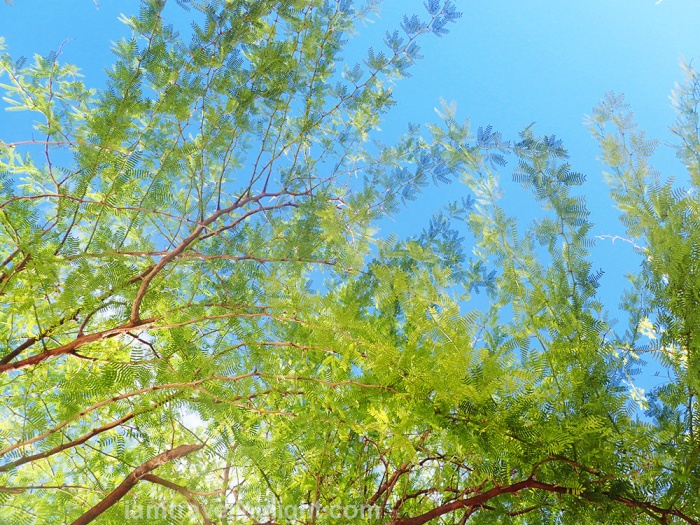
My relaxing view before falling asleep
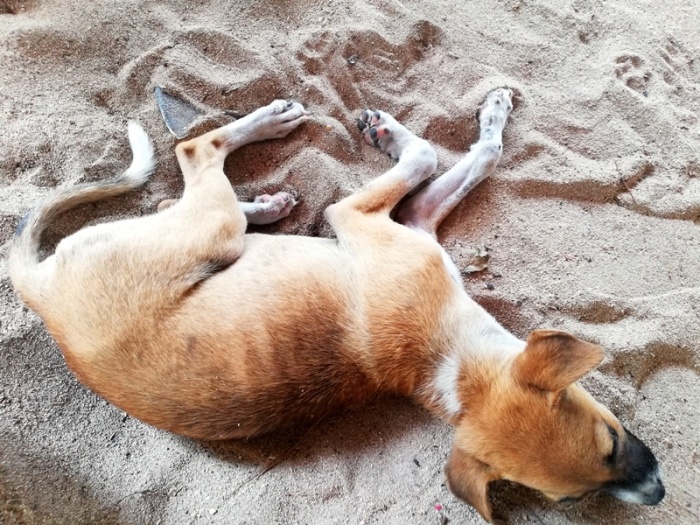
(APRIL 2019) Aroma, a dog named after the aroma trees, and owned by our homestay host
When I woke up, the tide had retreated closer to the horizon, and locals – many of them children – were gathering shellfish and other seafood.

Locals gathering shellfish during low tide in the afternoon
As I saw a woman and two children approaching the shore, I walked toward them, curious what from the sea’s bounty had they harvested in their pails.
The woman, Ate Neneng, gamely showed me their pails, and I was happy to find sea urchins, a favorite of my childhood summers in my father’s hometown in Ilocos, as well as a variety of edible shellfish.

Edible sea urchins, known as suwake in the island. Suwake is also the Bisaya word for them.
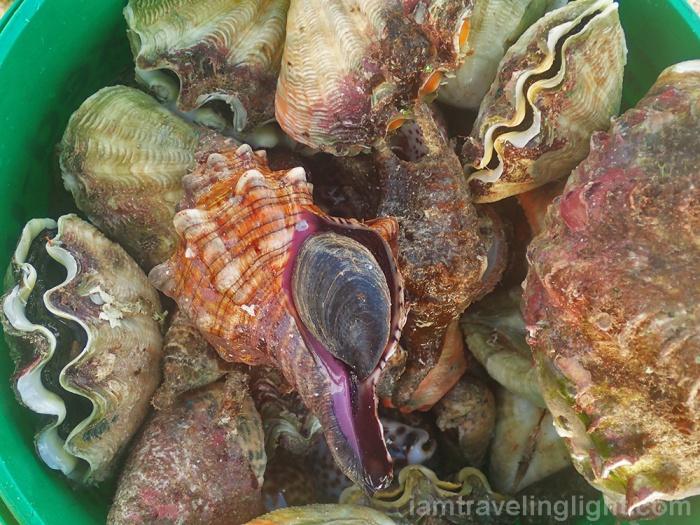
A variety of shellfish, some of which they call manlit.

Ate Neneng making her way back home after her sea harvest.
When Ate Neneng saw my excitement upon seeing the sea urchins, she immediately offered – and insisted – that I take them. I was touched by her generosity, easily extended without a second thought.
I carefully carried the three sea urchins before I resumed collecting shells, which would be part of the simple mandala my partner and I were making, our meditation and prayer for peace in Marawi, which had recently been attacked, and other areas in conflict.
I usually only get to make shell mandalas in quiet and laidback beaches where time seems to pass slowly, and Alibijaban was perfect there.

The mandala my partner and I made as a prayer for peace
After making the mandala, we basked in the afternoon’s sunset, still beautiful despite the clouds.
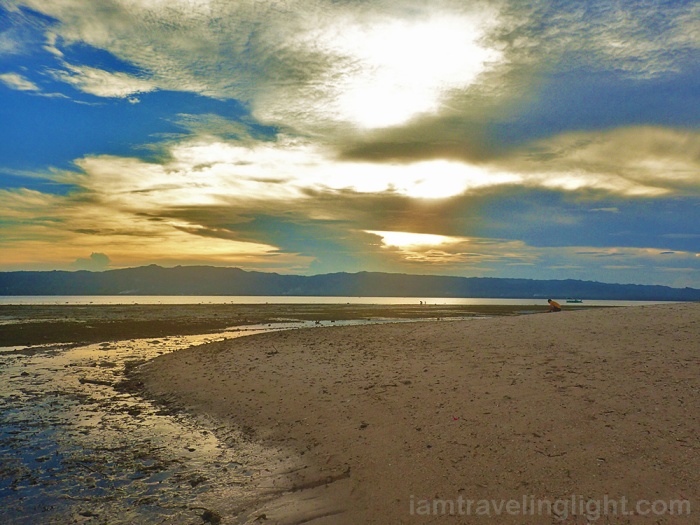
While the sun hid behind the clouds, the sunset was still beautiful.
Our dinner was another hearty meal, made extra special by fresh shellfish painstakingly prepared by Ronnel’s family and gathered earlier during the day. With a hammer, Ronnel’s dad Ronnie pounded one shell after the other from a sack full of shellfish, while Ronnel’s mother Genine and his brother Ronald sliced the springy meat and later cooked it with coconut milk.

Preparing shell fish for cooking requires patience – and I daresay love – and Ronnel’s family undoubtedly has them as they went far and above the usual hospitality preparing them for us.

Nanay Genine cooking the painstakingly prepared shellfish
After a delicious meal of rice, grilled fish, sinigang (sour fish soup), and the lovingly made shellfish, we went to where our tents were by the sea, played games my partner and I led, and laughed and bonded over stories. Afterwards, some made their way back to their tents, while some of us lied down under the stars and slept after seeing shooting stars. The Milky Way was in full view in the dark sky, making the night more magical.
I woke up around 5:30 am and tried to catch the sunrise, or what could still be seen of it. Mang Ronnie led us across the island on a shortcut. The sun was already up a cloudy sky, though, but it was still beautiful in that quiet morning.

Mang Ronnie leading us to where we could see the sun

The early morning sun above the island
One of my trip mates woke up earlier and was able to catch a spectacular sunrise, though. Below is his photo.

Sunrise at Alibijaban. Photo by Jonathan Martinez
After breakfast, we rode a boat that would take us around the island. The ride was breathtakingly peaceful, with the sea clear and mirrorlike in some parts of the trip.

The clear waters reflected the sky.

Sometimes, the sea seemed as still as a mirror.

An abundance of beach stars! Photo by Jonathan Martinez
Several times we saw colorful corals and starfish, and I felt a twinge of regret not bringing my snorkeling gear.
The tide was already rising when we docked at the sand bar, a usual spot visited by travelers, so the sand bar looked smaller.
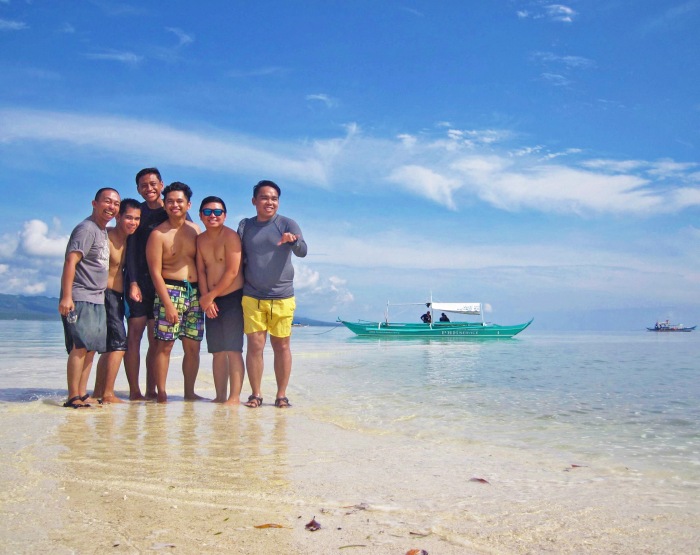
The boys happily posing for a sand bar photo. Photo by Patricia Sarte
Even as the tide rose, though, I appreciated the white sliver of sand still obvious beneath the clear waters, especially as I moved farther away in the water.

Even as the tide rose, the sand bar stood out in the water.
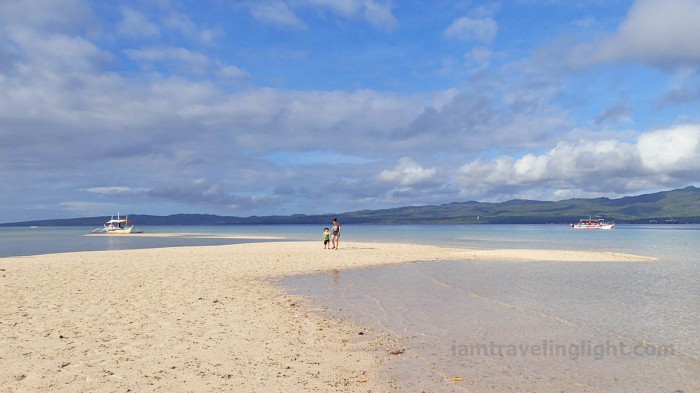
(APRIL 2019) On my second time to Alibijaban, it was nice to catch much of the sand bar still above water.
Next, we made our way to the neighboring mangrove forest, my favorite place on the island. Lush, green, and some parts glowing golden in the morning sun, the trees shaded us, sometimes even forming beautiful natural tunnels above us. And with the skies brilliantly blue above us, the mangroves’ greens looked more vibrant.

The mangroves’ greens and the skies’ blues took my breath away.

The mangroves beautifully shaded us from the sun.

The mangroves’ network of roots are also beautiful.

I loved how the waters reflected the mangroves’ green and the skies’ blue.

(APRIL 2019) On my second time to Alibijaban, I was able to venture farther out among the mangroves because of the later time of the low tide, and found this wooden bridge.
On our way back, some of us jumped into an expanse of clear blue waters that looked like a swimming pool in the middle of the sea and marveled at the visibly white sand at the bottom “shining” with the occasional starfish.

Breathtaking blues

(APRIL 2019) Alibijaban Island’s waters are still as clear as a swimming pool!
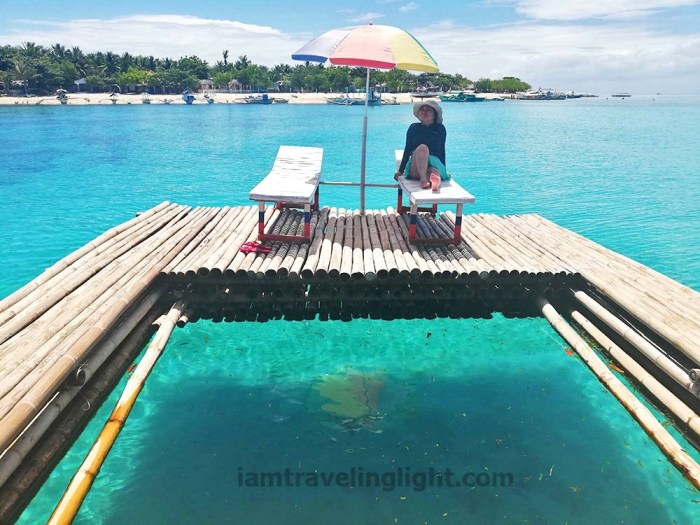
(APRIL 2019) On my second trip, my family and I were able to relax at a floating cottage! (P200 per hour. This is an optional cost.)

(APRIL 2019) The waters are so clear we could see coral reefs during our boat ride!
Upon reaching the shore, I took one last dip near the shore before we ate another hearty lunch, washed up, said goodbye to our friendly hosts, and road the boat back to the mainland.

I relaxed in the water for a last dip while watching paddle boats passing by.
Even though time seemed to go on forever in that island, it felt terribly short when it was time to say goodbye. While I had fully savored what I could during our more than 24 hours there, there was that feeling of still wanting more – more time to walk around, more time to have a relaxed conversation with locals, more time on the island. And yet, the experience also felt complete. Anyhow, this was always the feeling I had with islands that have captured my heart.

(APRIL 2019) Part of our last lunch in Alibijaban before leaving. Love the grilled fish especially – nothing like the taste of freshly-caught fish!

Nanay Genine and Ronald – some of our gracious hosts during our stay

Ronnel, our friendly and reliable host and tour guide
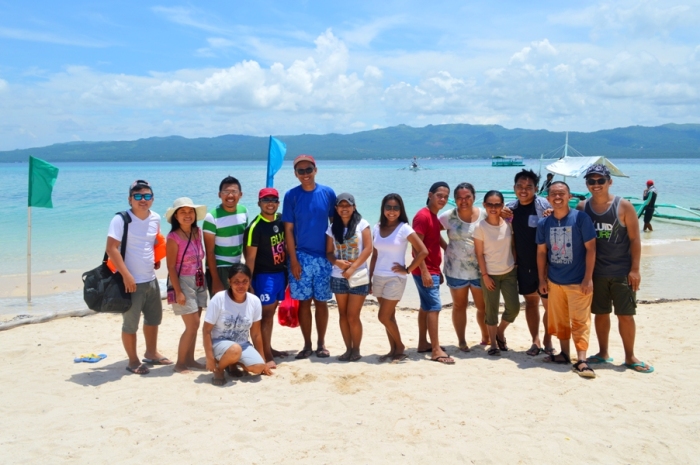
One last photo before leaving the island, together with Nanay Genine. Photo courtesy of Jherson Jaya

(APRIL 2019) Complete group shot with my family and Ronnel’s family! Ronnel and his family now call their humble and charming accommodation Aromajan, named after the tamarind-like trees in the area.

Back to San Andres port with some of the Aromajan family
Here is a video prepared by my older brother on our April 2019 Alibijaban adventure starring his son, my nephew Ken!
How to get to Alibijaban Island:
Ride a bus bound for San Andres. Fare is usually P500.
Alternatively, you can take a bus to Lucena. There are buses at Cubao-EDSA, Buendia-Taft, and Alabang, among other places. From Lucena, ride a van or bus to San Andres. Total travel time from Manila is around seven hours or more. Walk or ride a side car to San Andres port and then a boat to the island. Boat ride usually takes less than 30 minutes. Those traveling alone or in a small group have usually succeeded asking to ride with a local boatman, at a fee usually of P100 each. But, if you have a big group, better to rent a boat.
Alibijaban tour guide and homestay:
I highly recommend Ronnel Lirasan and his family, as we experienced warmth and overwhelming hospitality. (UPDATE: They now have a Facebook page! Message them at Aromajan Beach Resort or call them at +639279682237. Their homestay prices are also quite low and affordable (P1000 for rooms good for 4), and they go the extra mile when it comes to preparing food, offering fresh catch from the island if available too.
Sample budget and expenses:
Below is a sample budget for 14 people, assuming the standard costs in the island, though. 14 people is Ronnel’s recommended number for optimal cost, as boats can usually fit 14-15 passengers. Vans also usually fit up to 14 passengers. We were 13 people, and thus, we paid a bit more.
Van – P14,000 (including toll fee and gas) –>April 2019 updated rate. Some vans charge higher (Bus from Manila to San Andres is around P500, so van rate per person is about the same)
Overnight parking – P100
Driver’s food – P600 (optional, but we chose to pay for driver’s food)
Port fee – P56 (assuming P4 per person)
Environmental fee/entrance fee – P1820 (P130 each)
Rooms & tents – P1,900 (1 room, 3 tents) Best to get one room (also to leave stuff) and 2-3 tents to sleep near the stars! 1 room at P1,000 is good for 4-5 people, and 1 tent (P300) is good for 3-4 people. Both times I was in Alibijaban, I slept outdoors!
Boat to and from Alibijaban Island – P2,500 (good for 15 people. Boat rates start at P600 for 2 people)
Boat to sand bar and mangroves – P500 (Tip: You can actually walk across the island to see the sand bar and mangroves. But, if you want to go around the island via boat, snorkel, and swim in clear waters reminiscent of swimming pools but in the middle of the sea, I recommend taking the boat. At P500, it’s not a bad price)
Ingredients for meals from the public market – P4,500 (assuming your group of 14 has a healthy appetite like ours. Our group of 13 spent a little less than this amount)
Suggested cooking fee/tip – P1,000 (We had four generous meals of usually three ulam (dishes) + rice)
Suggested tip for host and tour guide – At least P1,000 (especially if he is as friendly and as hospitable as ours!)
Bathing water – P280 (assuming each person of the group of 14 bathes twice, and at P10 per pail)
TOTAL: P28,256 (approximately P2,018.3 per person)
Suggested weekend itinerary:
FRIDAY
10 pm – Depart Manila, preferably via van
SATURDAY
5:30 am – Arrive at San Andres. Breakfast and shopping at the public market for meals at the island
7:30 am – Depart San Andres port by boat
8 am – Arrive at the island. Leave bags at homestay. Walk around, swim, relax in hammocks, talk to the locals.
12 nn – Lunch and nap
4:30 pm – Resume exploring the island, swimming, and talking to locals
6:30 pm – Wash up then dinner
8 pm – Talking, bonding, stargazing
SUNDAY
5 am – Wake up and walk along the shore to the other side of the island to catch the sunrise
6:30 am – Breakfast
7 am – Ride a boat to sand bar, mangrove forest, and coral reefs for snorkeling or clear “pools” for swimming (Also check ahead or ask your host the time of low tide to maximize the sand bar. This part of the tour might be done the day before, depending on when low tide is)
12 nn – Wash up and lunch
1 pm – Ride boat back to mainland then depart San Andres
8:30 pm – Estimated arrival time in Manila
Hope you enjoy your time at Alibijaban Island as we did! Take a dip in its clear waters, visit the sand bar and mangroves, sleep under the stars, and talk to the friendly locals. And, help keep the island beautiful by disposing of your trash properly, among other things. Sharing with you also what I wrote about responsible travel, with tips from researchers and environmentalists.



Children playing, locals gathering shellfish, the sea, the sun, the sand, blue water. Mesimersing and peaceful.
Indeed. ^_^
Beautiful island indeed! We love the immense variety of features…lush mangroves, fine sand, simple community. We’re putting Alibijaban Island in our bucket list. 🙂
Yes! Really worth going to. 😉
Another beach destination for me 🙂
Yes! Worth a visit. 🙂
hi, do you think it is safe for solo female traveler? thanks 😀
Yes, I would say so. I am actually thinking of going back there alone hehehe.
Very informative. By the way, can you recommend the Van that you used when you went to Burias? My friends and I are planning to go there this summer and we hope you can help us. Thank you
Will ask my friend. Hopefully he still has the contact number.
Hi can i ask if there’s any number of kuya Ronnel? though we need to contact person before we go. kailangan po bang nka book kame bago pumunta baka po kasi maraming tao na at hindi kame ma accommodate. pupunta kame ngaung march 28 hanggang March 31 please help us po 🙂
You can find his contact number at the last part of the blog post. Enjoy your trip.
Kuya Rommel’ Globe # 0945 453 1495
Hi can i ask if there’s any number of kuya Ronnel? though we need to contact person before we go. kailangan po bang nka book kame bago pumunta baka po kasi maraming tao na at hindi kame ma accommodate. pupunta kame ngaung march 28 hanggang March 31 please help us po 🙂
Sorry did not see this post immediately but I hope you were able to find Kuya Ronnel’s number on my blog post.
is the boat ride to the island safe? Did they provide ife vest?
Yes, and it’s just around a 20-minute ride. Not sure if all boats going there offer life vests, though.
So I was planning to go there but my problem is I’m going solo like how much will I pay for boat rental and tour guide ?
My cooking fee pl@byad sa tour guide?pwd nb wl tour guide tsk mg ttent lng kmi nk motor lng kmi e
Hello. Kaya po kami nagbayad ng cooking fee kasi nagluto po talaga sila para sa amin. May overnight fee po, may dala man kayong tent or magrerent ng tent (separate bayad).
Hi updated po ba ung number ni Kuya Romel? Gaano po ito kalayo sa Baler? Planning to go to Baler after.
Yan ho ang latest number sakin. Malayo ang Baler since Quezon (Southern Luzon) ang Alibijaban and pa-north naman ang Baler.
Hi. We’re going there for a 5 day outreach stay, this Friday. is the Globe or Smart signal strong?
Globe is good, Smart not so much.
Hi! Is the boat ride to and fro the island rate fixed? or does it depend on how big your group is?
It depends how big your group is. I believe I mentioned sample rates on my biog post.
Hi. i’ve seen blog where they discussed difficulty in water supply in the island. is it true? planning to go there on holy week.
During my visit, there were faucets and water was stored in big containers. People would line up to take a bath, and the line was manageable. I imagine there would be more people during Holy Week.
Hi we are planning to visit this place this friday, do they have decent comfort rooms? Hehe, saka po ung rate ng mga kubo ba and tent is per night or thrughout ur stay (say 3D2N). TIA
Yes, basic but clean comfort rooms. Rate I indicated here is per night. We just stayed overnight on both trips. Enjoy! 🙂
Hi day tour lang po kami mga around 11 adults and 2 kids. How much po environmental fee and rent po sa boat.? Thank you
Costs po are at the last part of my blog post. Since mga 7 hours ang byahe, I recommend overnight po.
Hi were planning tp go there by august thank for the blog appreciate much thank you.
Enjoy your upcoming trip!
Planing to visit this coming 1st week of January..need help
Contact Ronnel Lirasan in the contact details I indicated above. He will be able to help you. Enjoy!